Albert Einstein
Middle Years
1906 - 1929
![]()
· After 1905 Einstein continued working in the areas of special relativity and energy equivalence. In 1906, Einstein was promoted at the patent office to technical examiner second class but more importantly during this time he also made important contributions to quantum mechanics. He was the first, even before Max Planck (the discoverer of quantum), to say that quantum theory was revolutionary. He sought to extend the special theory of relativity to phenomena involving acceleration. The key appeared in 1907 with the principle of equivalence, in which gravitational acceleration was held to be indistinguishable from acceleration caused by mechanical forces. Gravitational mass was therefore identical with inertial mass.
Difference between 'gravitational mass'(mG) and 'inertial mass' (mI). The observer would see no difference between the two accelerations, hence mG = mI.
![]()
· In 1908, he was licensed in Berne, Switzerland, as a teacher and lecturer, and resigned from the patent office the following year. Einstein’s second son, Eduard, was born in 1910 and the year after, Einstein was appointed full professor at the Karl-Ferdinand University in Prague. In fact, 1911 was a very momentous year for Einstein since he was able to begin making preliminary predictions about how a ray of light from a distant star, passing near the Sun, would appear to be bent slightly, in the direction of the Sun. This was highly significant as it led to the first experimental evidence in favor of Einstein's theory.
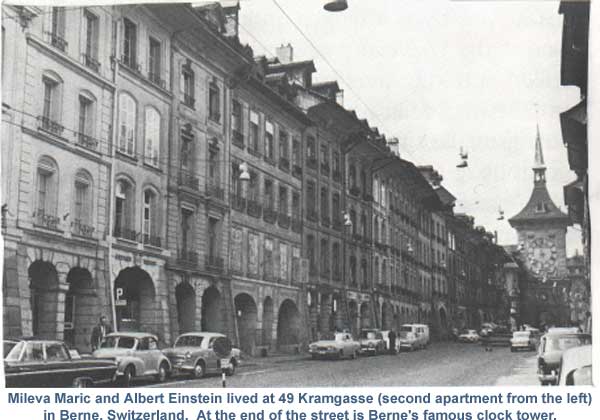
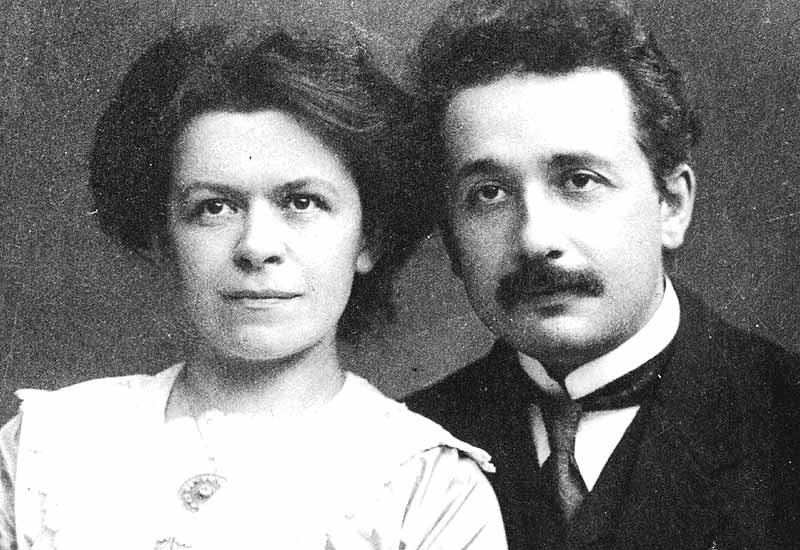
LEFT: Albert and Mileva's apartment in Berne, Switzerland; RIGHT: Mileva and Albert Einstien, 1911.
![]()
· In 1912, Albert began an affair with his cousin, Elsa Löwenthal. She was his first cousin (maternally) and his second cousin (paternally) and was 3 years older than Albert. Also during this time, Einstein began a new phase of his gravitational research, with the help of his mathematician friend Marcel Grossmann, by expressing his work in terms of the tensor calculus. Einstein called his new work the General Theory of Relativity. He moved from Prague to Zurich in 1912 to become the new chair at the Federal Swiss Polytechnic University.
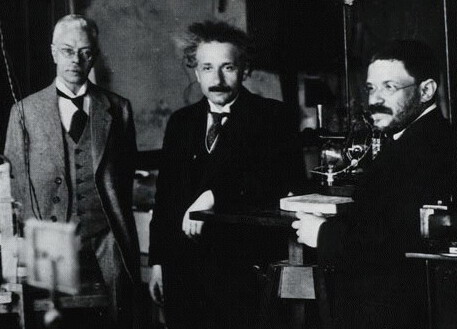
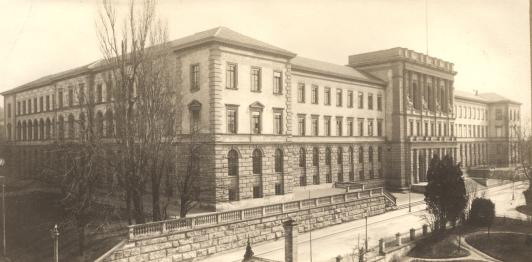
RIGHT: Einstein at a laboratory c. 1912; LEFT: The Federal Swiss Polytechnic University (Eidgenössische Technische Hochschule)
![]()
· In 1914, just before the start of World War I, Einstein settled in Berlin where he once more assumed German citizenship. Four months after moving to Berlin, he and Mileva separated and she took their sons back to Switzerland.
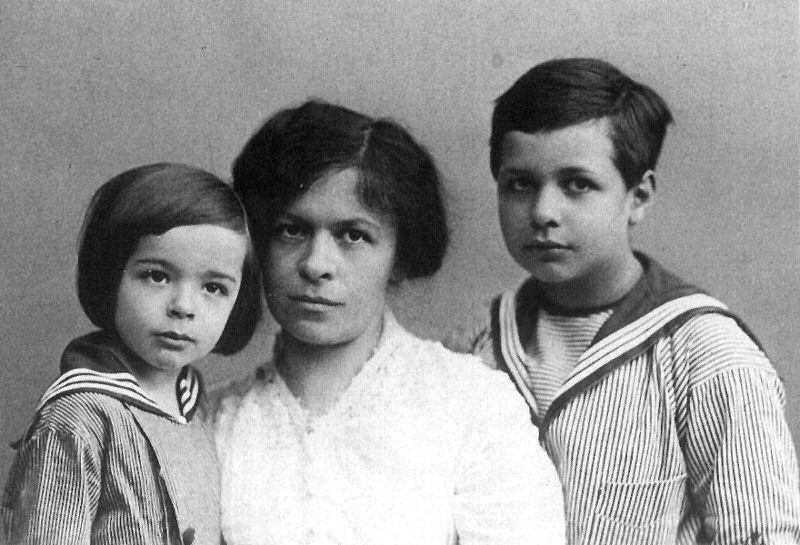
Eduard, Mileva, and Hans Albert in 1914
![]()
· While in Berlin, Einstein served as director of Kaiser Wilhelm Institute for Physics from 1914 to 1933, was a member of the Royal Prussian Academy of Sciences (which gave him all the research time he wanted), and received his Nobel Prize. However, his pacifism and Jewish origins outraged German nationalists. In late 1915, Einstein published the definitive version of General Theory.
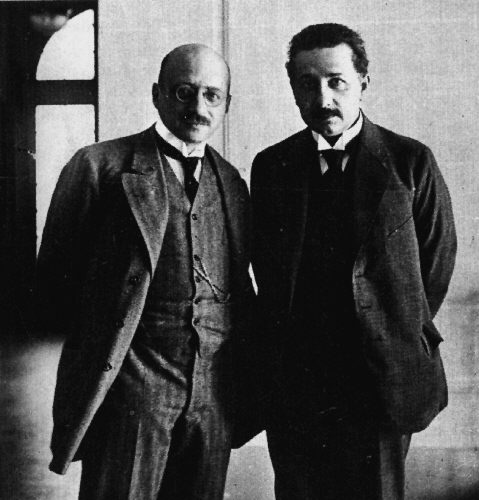
Fritz Haber and Albert Einstein in Berlin, 1914 (Age 35)
![]()
· Einstein was an accomplished amateur violinist, taking particular pleasure in performing Mozart and discussing the parallels between music and mathematics. His son, Hans Albert, recalled that "whenever he felt that he had come to the end of the road or into a difficult situation in his work, he would take refuge in music, and that would usually resolve all the difficulties."
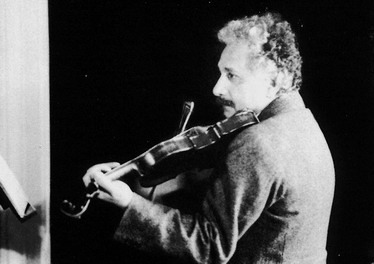
Einstein's mother introduced him to the violin at the age of 6 in an attempt to counteract his academic failures.
![]()
· In 1917, Einstein moved in with his cousin/lover Elsa Löwenthal in Berlin, where she nursed him back to health from a prolonged illness. Einstein published his first paper on cosmology this same year. He divorced Mileva in February, 1919 and then married Elsa in June of the same year. There were no children from this marriage, although Albert did adopt Elsa's daughters' Ilse and Margot. On May 29, 1919, a solar eclipse confirmed Einstein's General Theory of Relativity and he became world-famous when The London Times reported the success of his gravitational theory. After this the German nationalists began hating him even more.
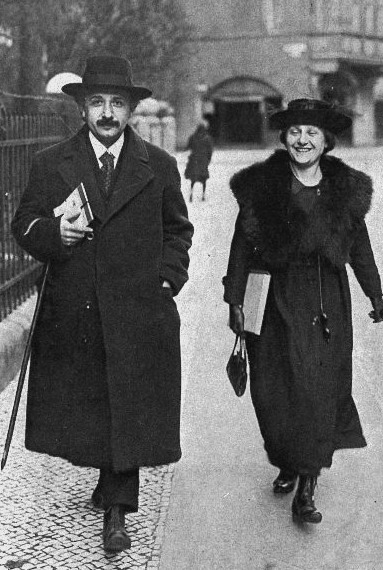
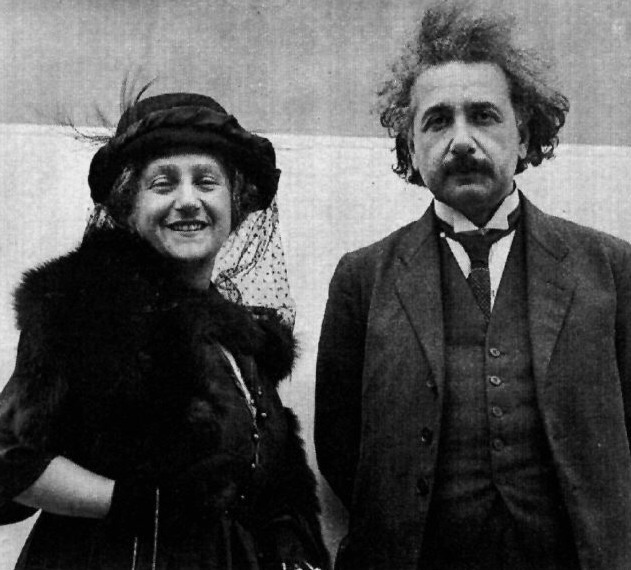
LEFT: Einstein with second wife - and cousin - Elsa, 1920; RIGHT: With Elsa on their journey back to Europe, June 1922
![]()
· In the 1920s, Einstein used his celebrity to speak out on Zionism, pacifism and democracy as often as he did to debate the finer points of relativity. Touring abroad regularly at the behest of various Zionist groups, Einstein became a prime target for the anti-Semitic forces gathering strength in his native Germany. During 1921, Einstein made his first trip to the United States. His purpose for the visit was to raise money for the planned Hebrew University of Jerusalem. Einstein lectured several times on relativity and he also received the Barnard Medal while in the U.S.
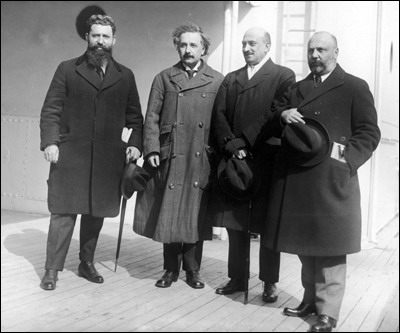
He is pictured here flanked by leading Zionists Theodor Benjamin Herzl, Chaim Weizman (the future president of Israel), and Meachim Usishkin.
![]()
· By the early 1920's, Einstein was the lead figure in a famous weekly physics colloquium at the University of Berlin. He was awarded the Nobel Prize in Physics in 1921 for his explanation of the photoelectric effect and for services to Theoretical Physics.
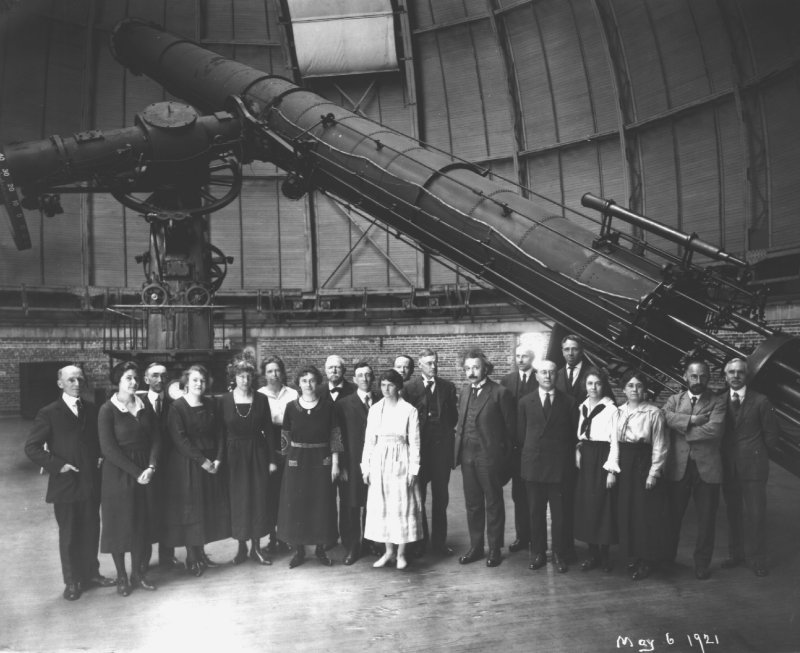
Einstein at the Yerkes Observatory in Chicago, 1921
![]()
· In the mid-1920s, the original quantum theory was replaced with a new quantum mechanics, Einstein balked at the Copenhagen interpretation of the new equations because it settled for a probabilistic, non-visualizable account of physical behavior. Einstein agreed that the theory was the best available, but he looked for an explanation that would be more "complete," i.e., deterministic. His belief that physics described the laws that govern "real things" had led to his successes with atoms, photons, and gravity. He was unwilling to abandon that faith.
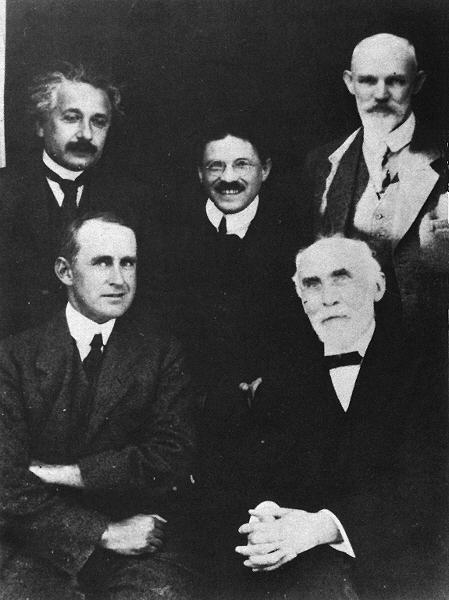
Einstein at Leiden University in the mid-1920's
![]()
· In 1924, Einstein received a short paper from a young Indian physicist named Satyendra Nath Bose, describing light as a gas of photons, and asking for Einstein's assistance in publication. Einstein realized that the same statistics could be applied to atoms, and published an article in German which described Bose's model and explained its implications. Bose Einstein statistics now describes any assembly of these indistinguishable particles known as bosons. Einstein also assisted Erwin Schrödinger in the development of the Quantum Boltzmann distribution, a mixed classical and quantum mechanical gas model - although he realized that this was less significant than the Bose Einstein model, and declined to have his name included on the paper.
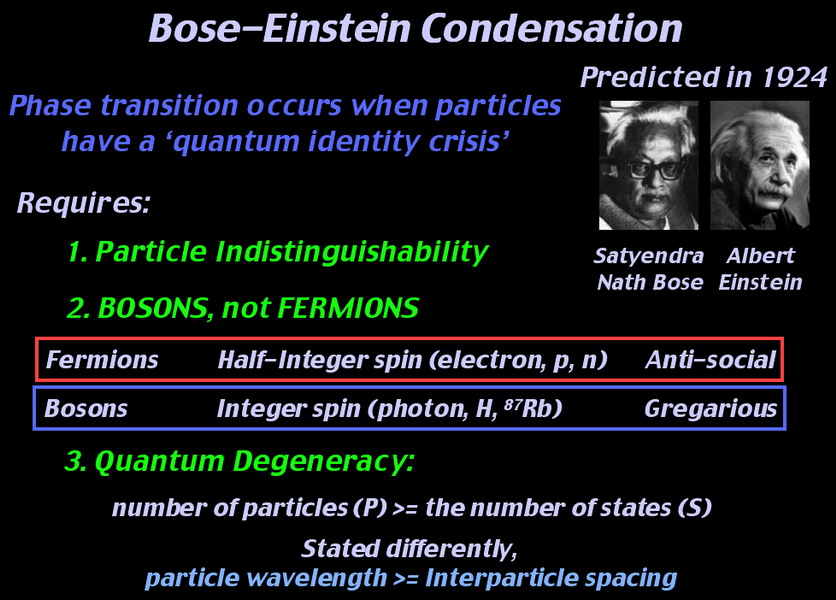
![]()
· In 1925 Einstein received the Copley Medal of the Royal Society and in 1926 received the Gold Medal of the Royal Astronomical Society. In 1927Albert attended his fifth Solvay Conference and with Niels Bohr, began developing the Foundation of Quantum Mechanics.
The Solvay Congress of 1927 (Einstein is in the middle of the front row)
![]()
· Einstein's health declined towards the end of the 1920's due to overwork and in 1928 he suffered a physical collapse. However he made a full recovery despite having to take things easy throughout 1928.
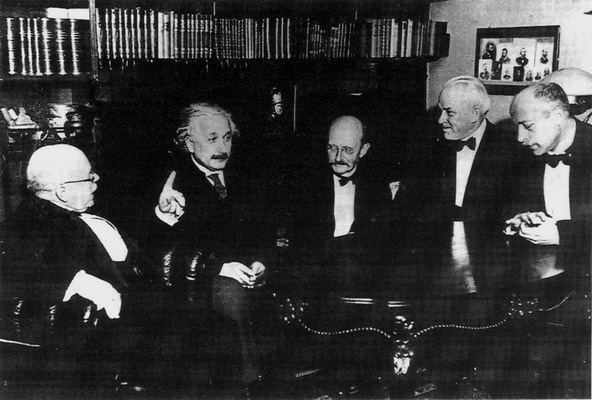
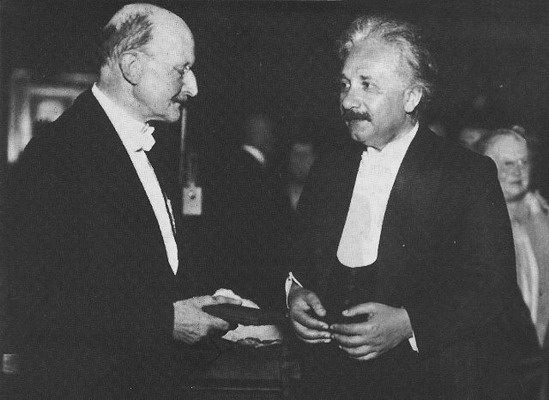
LEFT: Walther Nernst, Albert Einstein, Max Planck, Robert Millikan, Max von Laue in Berlin,1928; RIGHT: Albert Einstein and Max Planck in 1929
Go Back to the Albert Einstein Page